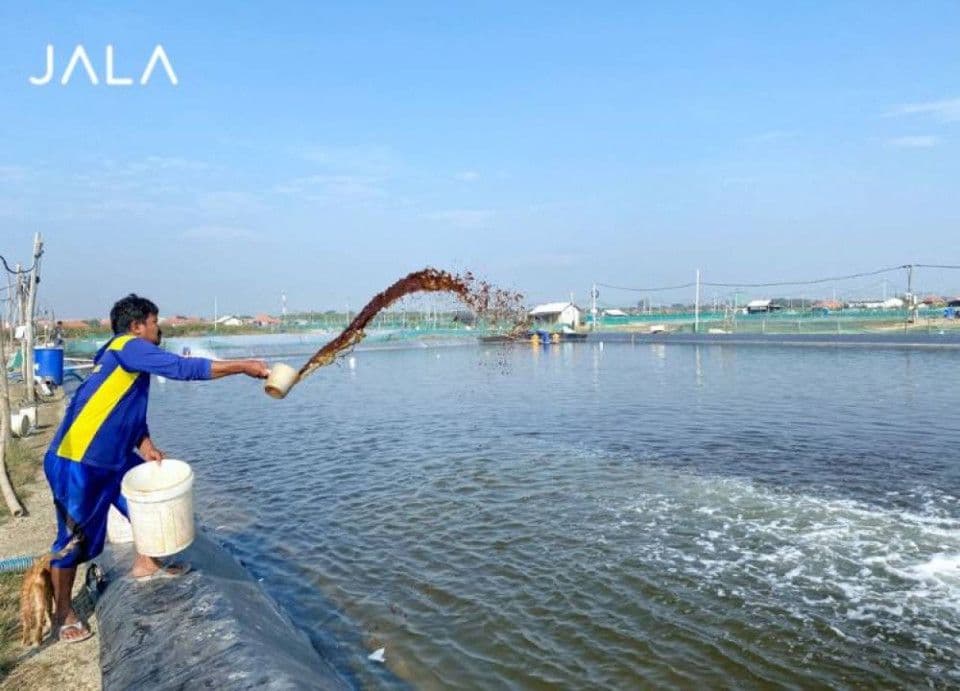
Just like all cultivated animals, shrimp needs feed to keep growing. According to Ayisi, et al. (2017), shrimp feed accounts for more than 50% of cultivation production cost. This is not surprising given that feed is one of the crucial aspects for increasing cultivation productivity and profitability.
The types of shrimp feed
Shrimp actually has a natural food source in the pond, which is the plankton. However, shrimp are also fed an artificial diet in the high density cultivation system such as intensive and super intensive.
The types of artificial diet or feed for shrimp are classified based on its shape and size, and tailored to the growth stage of the shrimp. This classification results in three (3) types of artificial diets, namely:
- Powder
- Crumble
- Pellet
This adjustment considers the shrimp’s mouth size, eating speed, and needs. This classification aims to optimize feed consumption and reduce feed residue.
The artificial diet's formula is adjusted to shrimp's nutritional needs. Protein usually takes up the highest percentage in the feed content since it is the main source of nutrition for shrimp. Feed with high protein content (35%-45%) results in a faster shrimp growth.
The characteristics of high-quality shrimp feed
Shrimp feed’s quality can be seen from its physical characteristics. A good-quality feed has uniformed color and size. It has a soft, dry, clean surface, and it does not merge and clot to one another. A uniformed feed size will raise shrimp’s appetite. Moreover, shrimp feed should also be appealing since shrimp tends to prefer feed with an appealing look and aroma.
Besides physical characteristics, the stability level of the feed in the water also becomes a feed quality parameter. Shrimp feed is considered good if it can remain steadily for 2-3 hours in the water. The feed will be harder to digest if it is longer than that time frame.
The importance of high-quality feed
High-quality feed will definitely result in healthy shrimp. However, to achieve the best cultivation results, the feeding process should be balanced with proper feed management. Poor feed management may lead to a high Feed Conversion Ratio (FCR).
Consider the action of feeding high-protein feed, for instance. Indeed, high-protein feed can cause shrimp to grow more rapidly. However, water quality is at risk to be polluted since high-protein feed causes an increase of ammonia, nitrite, and nitrate in the water.
Feeding low-protein feed also has a side effect even though it can suppress the operational cost. Shrimp growth tends to be less optimal and less faster than when shrimp is fed with high-protein feed.
In addition, farmers need to consider feed usage since feed takes up a great operational cost. Schedule feeding carefully and control feed intake by checking the feeding tray regularly.
Source:
Ayisi, et al. 2017. Recent Studies Toward the Development of Practical Diets for Shrimp and Their Nutritional Requirements. HAYATI Journal of Biosciences. 24(3): 109–117. https://doi.org/10.1016/j.hjb.2017.09.004
Hasan, M. R. 2010. On-Farm Feeding and Feed Management in Aquaculture. FAO Aquaculture Newsletter. 45: 48-49. https://www.fao.org/3/al363e/al363e21.pdf
SNI 7549-2009. Persyaratan Mutu Pakan Udang Vaname. Badan Standarisasi Nasional Jakarta.





